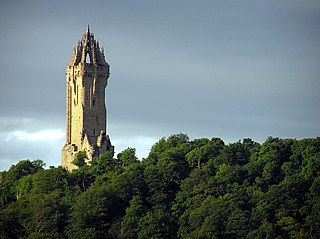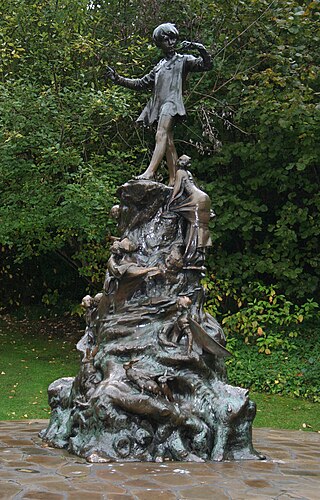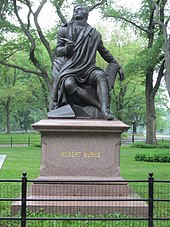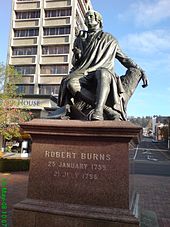
Sir John Robert Steell was a Scottish sculptor. He modelled many of the leading figures of Scottish history and culture, and is best known for a number of sculptures displayed in Edinburgh, including the statue of Sir Walter Scott at the base of the Scott Monument.

Cathedral Square, locally known simply as the Square, is the geographical centre and heart of Christchurch, New Zealand, where the city's Anglican cathedral, ChristChurch Cathedral is located. The square stands at the theoretical crossing of the city's two main orthogonal streets, Colombo Street and Worcester Street, though in practice both have been either blocked off or detoured around the square itself. The square was badly damaged in the February 2011 Christchurch earthquake.

The National Wallace Monument is a 67 metres (220 ft) tower on the shoulder of the Abbey Craig, a hilltop overlooking Stirling in Scotland. It commemorates Sir William Wallace, a 13th- and 14th-century Scottish hero.

George Edwin Bissell was an American sculptor.

First Church is a prominent church in the New Zealand city of Dunedin. It is located in the heart of the city on Moray Place, 100 metres to the south of the city centre. The church is the city's primary Presbyterian church. The building is regarded as the most impressive of New Zealand's nineteenth-century churches, and is listed by Heritage New Zealand as a Category I structure.

The Octagon is the city centre of Dunedin, in the South Island of New Zealand. It is an eight-sided plaza with a circular one-way carriageway, bisected by the city's main street, and is also the central terminus of two other main thoroughfares. The Octagon is predominantly a pedestrian reserve, with grass and paved features, and is surmounted by a statue of the Scottish poet Robert Burns. Several of Dunedin's significant buildings and institutions adjoin the plaza, which is also a major hub for public transport in Dunedin, primarily taxi services.

Moray Place is an octagonal street which surrounds the city centre of Dunedin, Otago, New Zealand. The street is intersected by Stuart Street, Princes Street and George Street. Like many streets in Dunedin, it is named for a street in the Scottish capital Edinburgh.

Stuart Street is one of the main streets of Dunedin, New Zealand. As with many of Dunedin's streets, it is named after a main street in Edinburgh, Scotland.

The New Zealand War Memorial in London is a memorial to the war dead of New Zealand in the First and Second World Wars, unveiled in 2006. Officially named "Southern Stand", the memorial was designed by architect John Hardwick-Smith and sculptor Paul Dibble, both from New Zealand.

Baxter Park is a 37 acres (15 ha) park located in the east of Dundee, Scotland. It was designed between 1862-63 and is the only complete park wholly designed by Sir Joseph Paxton in Scotland. The park is included in the Inventory of Gardens and Designed Landscapes in Scotland and it features a Category A listed pavilion designed by George Henry Stokes. Baxter Park and the surrounding streets form the Baxter Park Conservation Area. The park is used as a venue for annual Bonfire Night firework displays.

The statue of Robert Burns in Milwaukee, Wisconsin, is a work of public art by the Scottish artist William Grant Stevenson, RSA. The bronze statue, of the Scottish national poet Robert Burns, stands on a plinth of Nova Scotia pink granite with two bronze bas relief panels. The monument was donated to the City of Milwaukee by James A. Bryden.

Scottish art in the nineteenth century is the body of visual art made in Scotland, by Scots, or about Scottish subjects. This period saw the increasing professionalisation and organisation of art in Scotland. Major institutions founded in this period included the Institution for the Encouragement of the Fine Arts in Scotland, the Royal Scottish Academy of Art, the National Gallery of Scotland, the Scottish National Portrait Gallery and the Glasgow Institute. Art education in Edinburgh focused on the Trustees Drawing Academy of Edinburgh. Glasgow School of Art was founded in 1845 and Grays School of Art in Aberdeen in 1885.

Sir Walter Scott is an outdoor bronze portrait statue of Walter Scott and the writer's favorite dog Maida by John Steell, located in Central Park in Manhattan, New York. The memorial sculpture, a replica of the 1845 original in Edinburgh's Scott Monument, was cast in 1871 and dedicated on November 27, 1872. It was donated by resident Scottish-Americans.

The Dunedin Law Courts is a notable historic building in central Dunedin, in the South Island of New Zealand. They are located at the corner of Lower Stuart Street and Anzac Square, directly opposite the city's historic railway station. Since 1902, the building has been used as the city's law courts, and contains four court rooms, including the ornate High Court, as well as housing the offices and library of the Law Society.

The Cenotaph in the southern New Zealand city of Dunedin stands in the centre of Queen's Gardens, close to the city centre. It is the city's main war memorial.
Thomas John Clapperton FRBS was a Scottish sculptor, famous for the statue of Robert the Bruce at the entrance of Edinburgh Castle erected in 1929.

The statue of Peter Pan is a 1912 bronze sculpture of J. M. Barrie's character Peter Pan. It was commissioned by Barrie and made by Sir George Frampton. The original statue is displayed in Kensington Gardens in London, to the west of The Long Water, close to Barrie's former home on Bayswater Road. Barrie's stories were inspired in part by the gardens: the statue is at the place where Peter Pan lands in Barrie's 1902 book The Little White Bird after flying out of his nursery. Six other casts made by Frampton have been erected in other places around the world.

The Warehouse Precinct is an urban area of the New Zealand city of Dunedin. Sited on reclaimed land at the northernmost tip of the Southern Endowment, it lies between 1 and 2 kilometres south of The Octagon, the city's centre.

The Stuart Memorial is a statue of clergyman Donald McNaughton Stuart located in central Dunedin, New Zealand, adjacent to Queens Gardens. The memorial features a bronze statue of Stuart seated in a solemn pose, atop a large concrete, granite, and andesite plinth. Stuart was a locally renowned minister, educationalist, and community leader, and shortly after his death in 1894 a memorial committee was established. After several months of community fundraising, the committee contracted Wellington-based artist William Leslie Morison to model the statue, the first major civic commission given to a New Zealand artist. With a plaster model by Morison used as the base, the statue was cast at the W. Moore foundry in London. Unveiled in June 1898, the memorial was soon subject to various proposals for relocation, either to the Early Settlers' Hall or Knox Church, due to the highly trafficked location and obstruction by surrounding lamp posts. It was ultimately placed atop a taller plinth in 1922, following a temporary removal during the instillation of electric tram lines. A proposal circulated in the late 2010s to move the statue to the grounds of the University of Otago, where Stuart served as chancellor. The statue was again kept at its Queens Gardens location, and underwent cleaning and restoration work in 2020.






















